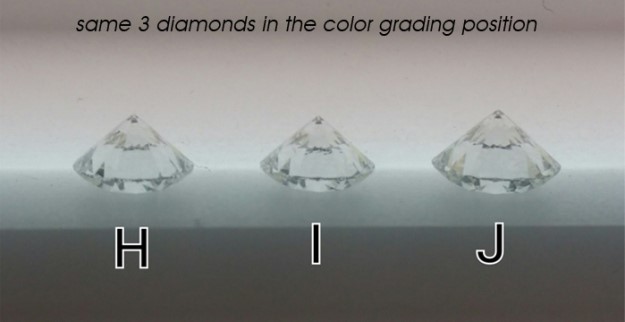By John Carter, CGA, CEO & President of Jack Lewis Jewelers
Choosing the diamond that is right for you means that you need to become a Jedi Master with the answers to these two questions:
- What area(s) should I spend money on?
- And more importantly: In what area(s) should I save money without it being obvious that I did so?
Ok. So, there you go. I’ve summed up this whole frustrating process with two questions. Now, go out there and make the right choice!
Not really that simple, I know. If it was, I wouldn’t have a job. Understanding those questions is one thing. Now you need to see practical examples of what this means in person.
Let’s single out color as our starting point. A good thing to remember when we discuss color in a diamond is that we are generally speaking about the absence or presence of yellow. Not to be confused with the occasional yellow flash you may see when you turn a diamond because that is something else. We are talking about the overall body color of that diamond.
Think in terms of shades of yellow like various glasses of lemonade. Some batches will just look more yellow than others. Same here, only remember that in diamond terms, the less color a diamond has, the more expensive it will be.

That brings us to two terms you should know: colorless and near colorless. The most colorless of all diamonds is D (don’t ask me why they don’t start at A…seems like that would be easier…but I digress) and then the color scale goes down through the letter Z. When we use the term colorless, we mean diamonds that would receive the grade of D-F. Near colorless means the diamond would fall into the color range of G-J.
So the question to ask yourself about colorless and near colorless would be, “How do they determine this? I mean, if F truly has no visible body color, then it should be a D…right?” Well, yes but the real buying tip is found in the determination of the grade. It’s all in how we actually grade the diamonds.
In order to see subtle differences in color from one diamond to another, we actually need to flip the diamond upside down and view it next to other diamonds we know are specific colors. We call these rather important comparison diamonds Master Diamonds or Master Stones.

The term colorless is used because it means that in the face up position (or when you are looking down at the diamond from the top of it) no color differences can be seen even by a trained grader. Even by a trained grader! It is only from the side that one can see the difference between a D, E, and F.

So I ask you, why would you spend your money on a D or an E when clearly an F looks awfully similar? Now I’ve sold (and currently own) plenty of D and E color diamonds, but I generally only buy them when the price makes sense in another area like clarity….which is what we’ll discuss in a future blog.
This takes us to the near colorless range…so called because in that same face-up position, there will be subtle differences in color from one diamond to the next. In other words, to the naked eye, these will still appear to be mostly lacking in color but it starts to become noticeable, even if just a little.
The exercise I like to do with clients in person is to show them one color and how it compares to the others. You do not need to be an expert to see why a D is a D when you compare it to an I color, and by looking at them this way it allows you to ask yourself the very valuable question: Is it worth the extra money?
And that is always the million dollar question and why it is essential to find someone you can trust to show you the differences. At the very least, know that you cannot be an expert in diamonds just by doing some research online.
Identifying what separates one diamond from another takes real world experience of viewing them in person, and the right jeweler will introduce you to that world and try to explain to you why they know what they do. Understanding color is as simple as D-Z, and being a savvy consumer is just knowing that sometimes color can be a great place to save a little money.